#main course varities
Explore tagged Tumblr posts
Text

* ꗃ event unlocked . . . CASINO NIGHT !

hey ues readers . it’s finally hitting seventy degrees out so that means spring is here and with that so are this season’s most anticipated events . and we’ve got word on a new exclusive grand opening party for you .
club 1919 is a new speakeasy that’s making waves in manhattan’s social circle . located in the basement level of the empire hotel , this club is rumored to be the next exclusive location . a callback to prohibition , this club serves prohibition-era cocktails and operate just like a speakeasy with a nondescript entrance requiring a password . but you didn’t think it’d be that easy , did you ? passwords change monthly and only communicated to members via word-of-mouth . this grand opening party is simply to give everyone a taste of what club 1919 has to offer .
and what better way to commemorate this opening than a casino night theme ? a perfect juxtaposition between elegance and pure debauchery . and of course , it wouldn’t be an event with manhattan’s elite without a dress code . this will be a black tie event and as usual , we expect to see your best .
event invites were sent out months in advance so i hope for your sake , your invitation didn’t get lost in the mail . word has it that the invite list is exclusive and comprised of celebrities , influencers and most of the upper east side social scene . anyone who’s anyone will be here . and as always , make sure your nepoupdates notifications are on ! we’d hate for you to miss out on a good time .

OOC DETAILS
out of character: this is a full length event ! the duration is three weeks , starting on friday , may 17th at 12:00 am est and will last until sunday , june 2nd at 11:59 pm est .
in character: the party will take place in the span of one night on friday , may 3rd at 8:00pm at club 1919 in the empire hotel . dress code is BLACK TIE FORMAL . along with the club's signature drinks catered specifically for the grand opening party , an open bar will be available to attendees as well as a varity of food selections . additionally , there will be live musical performances throughout the night . you can view this pinterest board for event inspiration . this is a dash only event .
event participation is optional , however highly encouraged ! by participating in the event , you can apply for 10 points from our points system ! points can be redeemed for both ooc & ic prizes .
please utilize the #nepofm.event009 tag for any event related posts be it muse outfits or starters . feel free to share your muse’s outifts in our ooc discord channels as well !
nepoupdates will be interactively involved in the event . muses can send in anonymous ( or not ) tips to the gossip blog .
once the event is over , you may continue & finish the threads from the event but please do not start any new ones ! if you decide to fade to black plots for event , please leave plotting updates for nepoupdates .
finally , this event is 100% about character & connections development as well as fun for both muses & muns ! if you have any questions , please don’t hesitate to reach out to admins on main or through our #questions channel on discord !
7 notes
·
View notes
Text
Tilling the fields, QMYS, Section 1
The Qimin yaoshu齊民要術 (“Essential Techniques for the Common People) by Jia Sixie (fl. c. 540), is the oldest Chinese agricultural treatise to survive in its entirety. Jia Sixie served as a mid-level official of Eastern Wei,as such the focus is on the dryland farming practices of his home region in modern Shandong rather than the wet rice agriculture of Southern China. The book itself mixes Jia Sixie's own advise and descriptions with quotations from earlier works, many of which are now lost. The QMYS is therefore not just an important source for the author's own times, but for the agricultural writings and practices of the preceding centuries.
Section 1 covers the different aspects of tilling the fields in preparation for cultivation, and contains advise for how to clear new fields, ploughing, harrowing, different soil types, and so on.
(To go straight to the translation, jump to "Section 1, Tilling the Fields")
[Translator's preface]
[The QMYS is not illustrated, but texts of this nature really should come with some visual aides. I have therefore included here some drawings and pictures from later eras. All images from Wikipedia.
[Farming tools]
Han era scholars agreed that China's first plough had been a tool called leisi耒耜, but lacked a clear of concept of how it actually looked like. Later authors simply repeated their statements. The drawing below from Wang Zhen's (1271-1333) Nongshu is therefore at best a reconstruction from literary evidence.

(Leisi耒耜, from Wang Zhen's Nongshu)
The main plough was instead the ox-pulled li犂 frame-plough.

(Li犂, from Wang Zhen's Nongshu)
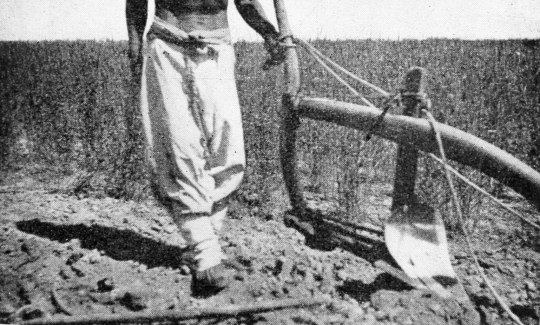
(Shantung plow, from King, 1911, Farmers of forty centuries)
QMYS also refer to the lighter feng鋒 plough.

(Feng鋒, from Wang Zhen's Nongshu)
The QMYS is the oldest Chinese text to refer to the iron-tined harrow, which it refer to as loucou𨫒楱

(Ba耙, from Wang Zhen's Nongshu)
The lao勞 bush-harrow was made by weaving thin sticks around the cross-bars.
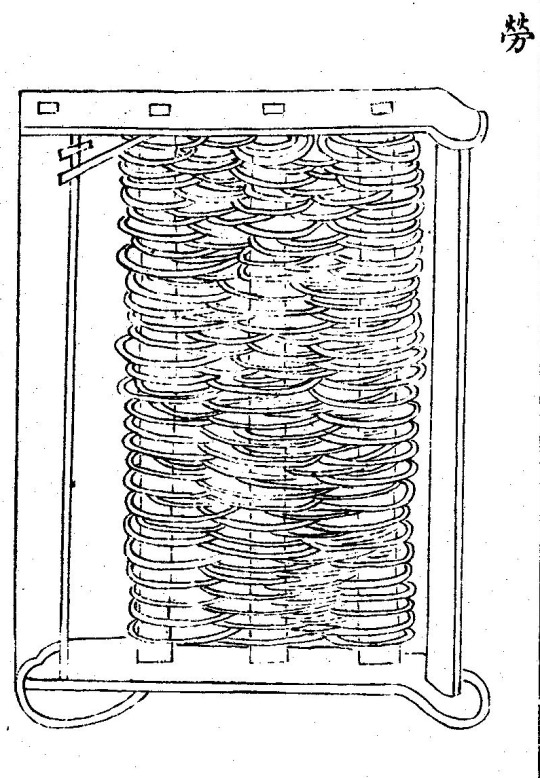
(Lao勞, from Wang Zhen's Nongshu)
The preferred tool for sowing was the seed drill, lou耬
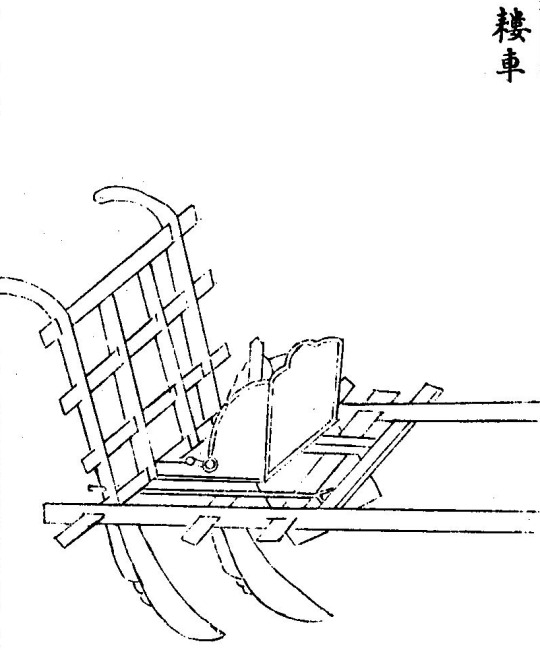
(Louche耬車, from Wang Zhen's Nongshu)
In addition to these ox-drawn tools, there were of course a varity of manual tools in different shapes and sizes, hoes, shovels, etc.
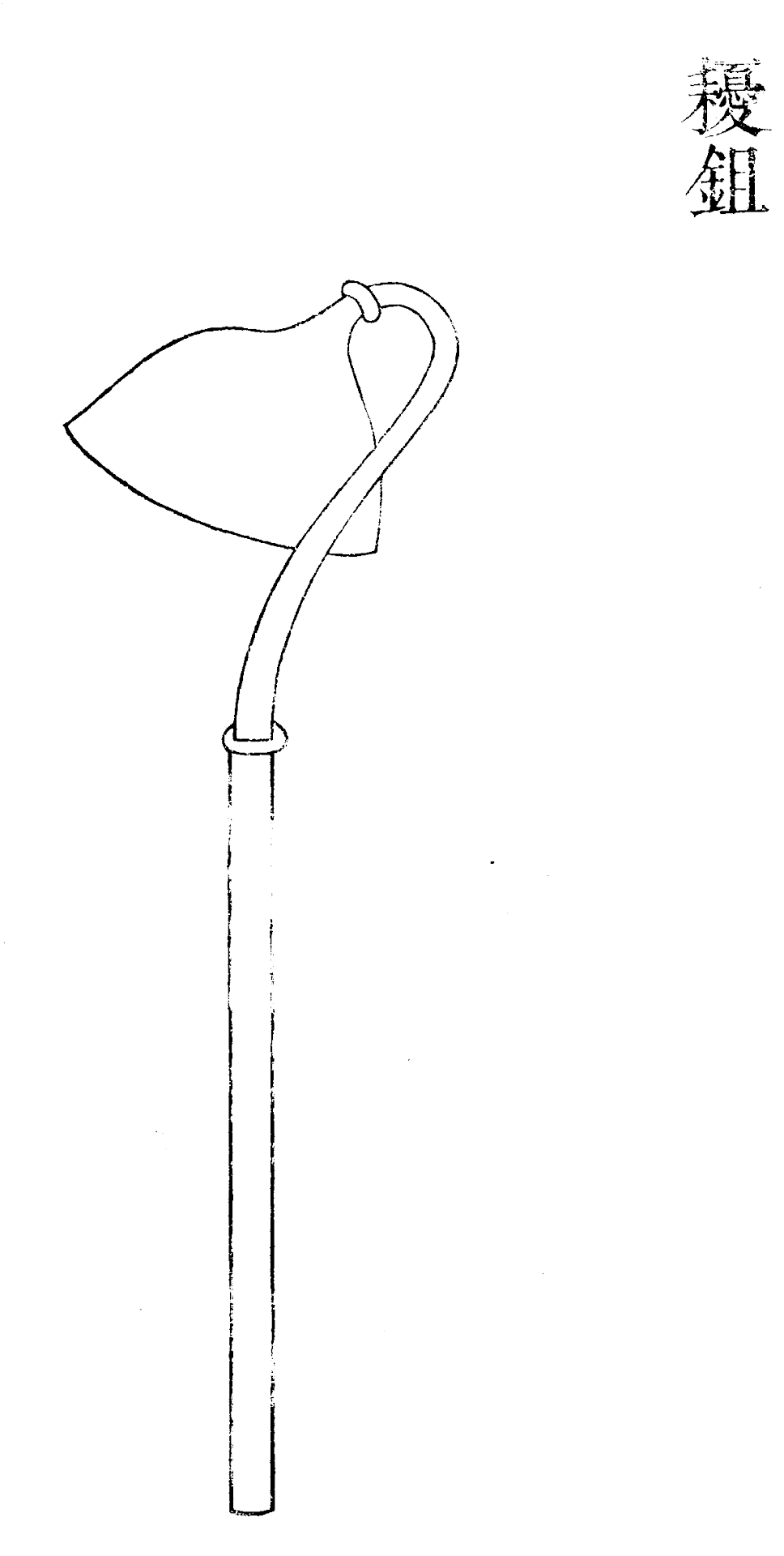
(Youchu耰鋤, from Wang Zhen's Nongshu)
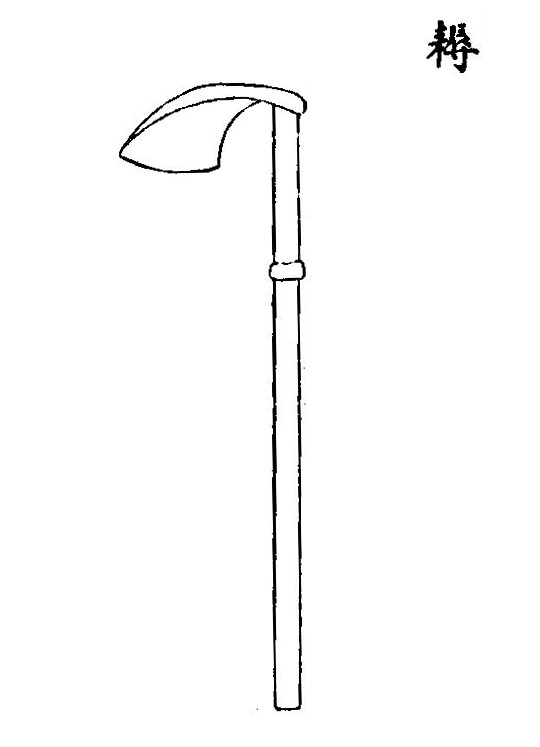
(Nou耨, from Wang Zhen's Nongshu)
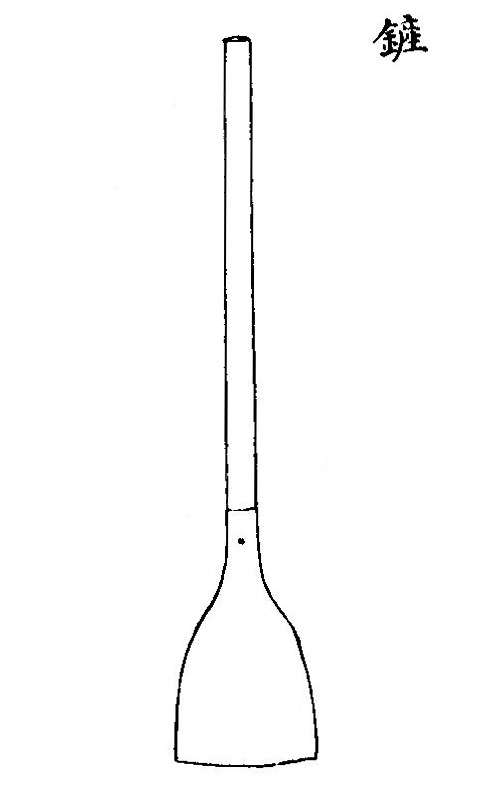
(Chan鏟, from Wang Zhen's Nongshu)
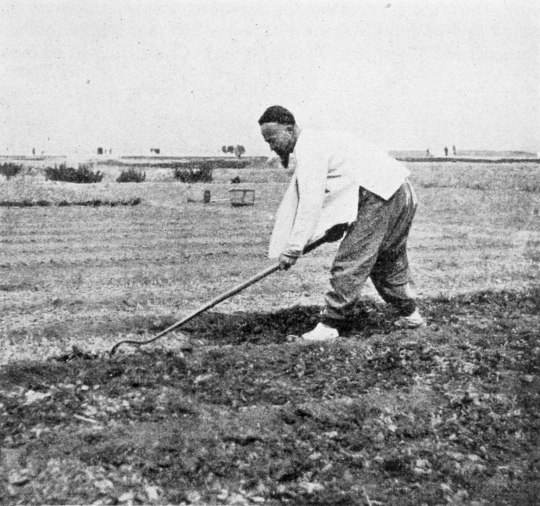
(Method of using the broad, heavy hoe in producing surface mulch, as seen in Shantung, China, from King, 1911, Farmers of forty centuries)
[Crop plants]
Later sections of QMYS treats the cultivation of the individual crops in much larger detail.
Foxtail millet (Setaria italica), gu穀, was the main staple crop.

Broomcorn millet (Panicum miliaceum), shu黍
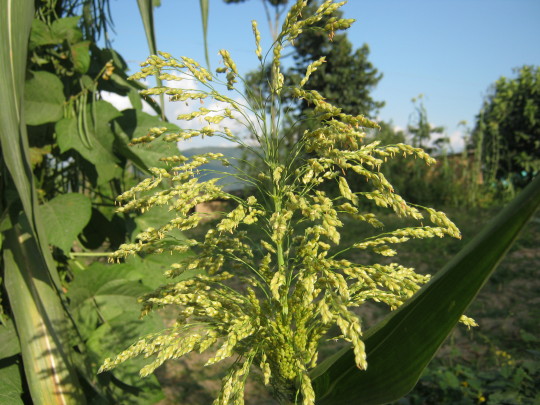
In addition to gu and shu, different varieties of foxtail and broomcorn millet were known under a large number of other names.
Mung beans or green gram (Vigna radiata), lüdou緑豆 (lit. "green beans"), used as green manure in crop rotation with millet

Adzuki beans (Vigna angularis), xiaodou小豆 (lit. "small beans") served a similar function
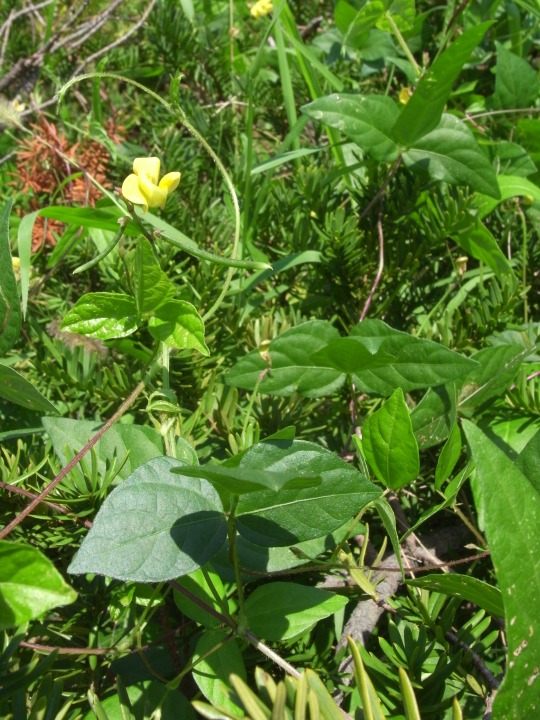
Wheat (Triticum aestivum), mai麥 (same name also used for barley) was primarily a winter crop in ancient China.

[Books quoted by QMYS in Section 1, in order of appearance]
The Zhoushu周書 (“Book of Zhou”), also known as the Yi Zhoushu逸周書, is a Warring States era collection of documents about Western Zhou, but the book has a complicated textual history. It is quoted once in QMYS, in Section 1. The quoted text is not found in the transmitted version.
The Shiben世本 (“Generational Roots”) records the genealogies of mythical rulers, the origin of the clan names, and mythological and historical inventors. Several versions existed, by different authors. The full text now lost, but it is quoted numerous times in other works. It is quoted once in QMYS, in Section 1.
The Lüshi chunqiu呂氏春秋 (“Spring and Autumn of Mister Lü”) is a collection of treatises and essays attributed to the retainers of Lü Buwei, the (in)famous Qin chancellor. It covers a very wide range of topics.
The Erya爾雅 (“Approaching the Correct”) is the oldest surviving Chinese glossary. Modern scholarship dates the book to the late Warring States and/or early Western Han periods. It is quoted numerous times in QMYS.
The Jianwei shiren犍為舍人, the “Retainer from Jianwei”, lived during the reign of Emperor Wu of Han and wrote a commentary on the Erya. The book is now lost. The quote in Section 1 is the first of three in QMYS.
The Zuanwen 纂文 (“Compiled Graphs”) by the Liu-Song scholar and historian He Chengtian何承天 (370 – 447) is now lost. It is quoted once in QMYS, in Section 1.
The Shuowen 說文 (“Explaining Graphs”) by Xu Shen許慎 (c. 58 – c. 147) analyses the composition and reasoning behind the different characters. It is quoted numerous times in QMYS.
The Shiming釋名 (“Analysing Names”) by Liu Xi劉熙 is a glossary in the style of the Erya written c. 200 AD. The quote in Section 1 is the first of three in QMYS.
The Liji 禮記 (“Ritual Records”) is a collection of ritual treatises compiled from older texts during Former Han, it became part of the textual canon as one the Five Classics and also as one the Three Ritual Classics. Its usage in QMYS is restricted to the Yueling chapter.
The Yueling月令 (“Monthly Orders”) chapter of the Liji is a calendrical treatise describing for each of the twelve months the position of the stars and other seasonal markers, important state rituals, and which activities should be undertaken in each month. Its inclusion in the Liji ensured it what read by every person aspiring to an education and it inspired a whole genre of similar texts, such as the Simin yueling. It is extensively quoted in QMYS.
Zheng Xuan鄭玄(127 – 200) was a famous scholar at the end of Han who wrote an influential commentary on the Three Ritual Classics. In QMYS quotations from the Yueling and Zhouguan are usually accompanied by quotes from his annotations.
Mengzi孟子 (“Master Meng”, theLatin Mencius) collects the teachings of the famous Warring States era philosopher Meng Ke (372–289 BC). The quote in Section 1 is the first of three in QMYS.
Wei Wen-hou魏文侯, Marquis Wen of Wei, ruled Wei during the early Warring States era. The single quote in QMYS attributed to him is found in the Huainanzi.
The Book of Miscellanea on Yin and Yang雜陰陽書 was apparently written during the early Han, but is now lost outside the quotations in the QMYS. The quote in Section 1 is the first of eight in QMYS.
Gao You高誘 lived at the end of Han and wrote commentaries on several texts, including the Lüshi chunqiu and the Huainanzi. The quote in Section 1 is the first of eight in QMYS.
The Huainanzi淮南子 (“Masters of Huainan”) is a collection of philosophical treaties compiled during Western Han at the court of Liu An (179 – 122 BC), vassal king of Huainan. It covers a wide range of topics. The quote in Part 9 is the second of nine in QMYS, the first being in the preface (which I have impudently skipped).
The Fan Shengzhi shu氾勝之書 (“Book of Fan Shengzhi”) is the oldest known Chinese agricultural treatise. Fan Shengzhi might originally have been an easterner, but during the early Western Han served as an official in the Guanzhong region. The original book has been lost, but it is extensively quoted in the QMYS, and also by Tang and Song encyclopedias.
Cui Shi崔寔 (d. c. 170) was a Han official and author of multiple works, including the Simin yueling and Zhenglun.
The Simin yueling 四民月令 (“Monthly Orders for the Four People”) is written in the style of the Liji Yueling, detailing each month's agricultural activities at the large estates of late Han North China. The original book is lost except as fragments in other books. It is very extensively quoted in the QMYS.
The Zhenglun政論 (“Essay on Government”) criticizes what Cui Shi considered the decline in morals and lax administration of law in his time. The original book is lost except as fragments in other books. It is quoted once in QMYS, in Section 1.
[Lettered notes]
The original text is a mix of large and small characters. I have collected the small text sections together in idented lettered notes within {} brackets.]
[Translation starts here:]
Section 1, Tilling the Fields
[Dictionary definitions]
The Book of Zhou says: “In the time of the Divine Farmer, Heaven rained millet [su粟]. The Divine Farmer thereupon tilled and planted it. He created pottery, cast axes and hatchets, and made the plough-shaft and ploughshare [leisi耒耜], the long- [chu鉏] and short-handle hoe [nou耨], to clear the grass and thickets. Afterwards the Five Grains supported and helped, and the Hundred Fruits were stored in abundance.”
The Generational Rootssays: “Chui created the plough-shaft and ploughshare. Chui was a vassal of the Divine Farmer.”
The Spring and Autumn of Mister Lüsays: “The ploughshare is six cun wide.”
The Eryasays: “To mow[qu斪] or weed[zhu斸] are spoken of as to settle [ding定].”
The Retainer from Jianwei says: “To mow or weed is to hoe [chu鋤]. They are names for settling.”
The Compiled Graphssays: “In the way of tending sprouts, the long-handle hoe [chu鋤] is not as good as the short-handle hoe [nou耨], the short-handle hoe is not as good as shovel [chan鏟]. A shovel is two chi long, with a blade two cun wide, and is used to level the ground and remove grass.”
Xu Shen's Explaining Graphssays: “The plough-shaft [lei耒] is for hand-tilling with a curved wood. The plough-share [si 耜] is the plough-shaft's straight end. The weeder [zhu斸] is for cleaving [zhuo斫]. In Qi they speak of it as the ziji鎡基. Some say the axe handle [jinbing斤柄] is curved by nature. A field [tian 田] is laid out [chen陳]. Where is planted grain is called a field. [The graph] resemble four 口, and the 十 is the pattern of paths and cross-paths. To till [geng耕] is to plough [li犂]. [the graph] comes from “plough-shaft” 耒 with the “well” [jing井] sound. Some say it is the ancients' well field [system.]”
Liu Xi's Analysing Names say: “A field [tian田] is full [tian填]. The five grains fill up within it. A plough [li犂] is profit [li利]. To profit, turn over the soil and cut off the grass at the root. The short-handle hoe [nou耨] resembles hoeing [chu鉏], with crouched back hoe among the stalks. To weed out [zhu] is to execute [zhu誅] someone. The ruler uses execution to dig up a matter at the root.”
[General advise]
In general, when opening uncultivated mountain and marsh fields, always in the 7th Month cut down and mow them. When the grass has dried, set fire to it. Arriving at spring, begin to clear out those of its groves where the wood is large, peel off the bark to kill them. When the leaves are dead and not casting shadow, they will readily yield to tilling and planting. After three years, when the roots have withered and the stalks decayed, use fire to burn them (entering the ground fully), till the uncultivated land to the end, and use an iron teeth loucou𨫒楱 harrow to rake it twice everywhere, hurl broomcorn non-glutinous millet, and bush-harrow [lao勞] it again twice everywhere. Next year then it is fitting to be a millet field.
In general when tilling eminent or inferior fields, do not ask about spring or autumn, [you] must pay attention to dry or wet to obtain what will be good. If flood and drought are not in concert, it is better with dry and not wet {A}. For the spring tilling, immediately take in hand the harrowing{B}. For the autumn tilling, wait for the turn to white to harrow{C}. [When the soil starts to dry, the surface turns white, which Jia Sixie refers to as 白背.]
{A: With dry tilling, then even if there are earth-clods, as soon as there is rain, the earth will pulverize and dissolve. With wet tilling, it will harden when it dries, and for several years will not be good. The proverb which says: “Wet tilling and damp hoeing is not as good as going home.” tells that it is of no gain and will be damaging. In the case of wet tilling, when it turns white quickly use the loucou on it, and there will likewise be no injury. If not done, it will be very bad.} {B: The ancients said you耰, now we say lao勞. The Explaining Graphs says: “The you is a tool for rubbing [mo摩] the fields.” Now people also name the lao bush-harrow a “rubber” [mo]. A vulgar saying is “till the field with the rubbing harrow”.} {C: During spring, there is much wind, and if [you] do not soon harrow, the earth will surely be empty and dry. During autumn the fields are soaked solid, and wet harrowing will make the earth stiff. The proverb which says: “To till and not to harrow is not as good as making it go to waste” perhaps tells that wetlands are difficult to handle, and delights in Heaven's timely chances. Huan Kuan's essay on Salt and Iron says: “Underneath a thick grove there is no lush grass. Between large clods there are no excellent sprouts.”}
In general, autumn tilling want to be deep, spring and summer tilling want to be shallow. Ploughing want to be narrow, harrowing want to be double{D}. In the autumn to till and cover over what is green is the best.{E} The earliest tilling want to be deep, and the turned over earth want to be shallow.{F} On land with themeda or cogon-grass [jianmao菅茅], [you] ought to let loose cattle and sheep to trample it. Then if in the 7th Month [you] till it, it will die{G}.
{D: Plough narrow and till finely, the ox then will not tire. Double-harrow and the land will ripen, during drought it will likewise protect the moisture.} {E: Reaching the winter months, the green grass that has regrown will be as excellent as adzuki beans [xiaodou小豆].} {F: If the tilling is not deep, the land will not ripen. If the turned over is not shallow, the stirring will bring forth the soil.} {G: If not the 7th Month, it will regrow.}
In general, the rule for excellent fields, is for mung beans [lüdou緑豆] to be first, adzuki beans and sesame [huma胡麻] is next to it. Thoroughly for all of them sow densly [?] within the 5th and 6th Months, and in the 7th and 8th Month plough and cover over to kill them. [This] will make a spring millet field with a harvest of ten shi on the mu, in excellence comparable to silkworm excrement and mature manure.
In general, after the autumn harvest, the oxen's strength will be weak. For those not yet caught up for autumn tilling, at the bringing down of [?] the foxtail [ gu穀], glutinous broomcorn [shu黍], non-glutinous broomcorn [ji穄], large grained [liang 粱], and glutinous foxtrail [shu秫]millets' stubble, then move the exhausted ones to quickly use the “spear-point plough” [feng鋒] on it. The ground is regularly soft and moist, and is not hard and tough. Then when arriving at the beginning of winter, [you] usually get to till and harrow, and not worry about it being dried up and arid. If the oxen's strength is small, only harrow it once during the 9th and 10th Months, and arriving at spring, sow without ploughing [?], is also doable.
[Excerpts from the Monthly Orders on tilling]
[This whole subsection consists of quotation from the classic text the Monthly Orders [Yueling 月令], a chapter of the Ritual Records [Liji禮記], accompanied by quotations from commentary by the Eastern Han scholar Zheng Xuan.]
The Ritual Records' Monthly Orderssays: “In the Month of First Spring, … the Son of Heaven therefore on the inaugural day pray for grain to the High God [shangdi上帝]{H}. Then, selecting the inaugural chen day, the Son of Heaven personally conveys the plough-shaft and ploughshare. … He leads the Three Excellencies, the Nine Dignitaries, the various feudal lords, and the great men, to till themselves the God's Acre [Di ji帝籍]{I}. This Month, Heaven's breath descends down and Earth's breath rises up. Heaven and Earth are in harmony with each other, and the grasses and trees sprout and stir{J}. … He instructs the ministers for the fields{K}. They skilfully assess the hills and mounds, the slopes and defiles the highlands and lowlands, for what is suitable among the land and ground, and what to plant of the Five Grains, so as to teach and guide the people. … Field affairs having been put in order, he first settles the guidelines and responsibilities. Agriculture was therefore not in confusion. ...”
{H: Zheng Xuan's Annotations says: “It speaks of the first xin day, and the suburban sacrifices to Heaven. The Spring and Autumn Transmittals says: 'In spring the suburban sacrifices to the Lord of Agriculture [Houji后稷] to pray for farming affairs. Thus after the commencement of hibernation, the suburban sacrifices. After the suburban sacrifices, the tilling.' The High God is the god of the Grand Tenuity [taiyi太微].”} {I: “Inaugural chen is perhaps a propitious chen day after the suburban sacrifices. … The God's Acre is the field by which is regulated the Heavenly Divinity's lending the people strength.”} {J: “This is the yang breath ascending through the surface, a portent that there can be tilling. The Book of Agriculture says: 'For the best growth cover over the stakes. When they show the base and can be pulled out, those who till urgently set out.”} [This Book of Agriculture [nongshu農書] is apparently the same as the Book of Fan Shengzhi which is quoted in more detail on this topic further down.] {K: “With minister it speaks of the 'field surveyors', the officials in charge of agriculture.”}
“In the Month of Middle Spring, … those who till have a short rest, they then repair their gate and door leaves [heshan闔扇]{L}. There are no great affairs undertaken which would hinder agricultural affairs. … ”
{L: 'Rest' [she舍] is similar to 'pause' [shi止]. Hibernating insects open doors, and with tilling affairs a little tranquil, they then put in order their gates and doors. When they use wood it is called he闔, when they use bamboo or reeds it is called shan扇.”}
“In the Month of First Summer, … he encourages agriculture and motivates the people, and there are not anyone who neglects the season{M}. … He instructs the farmers to apply themselves to action, and not rest at the capital{N}. ...”
{M: “He puts weight and effort in encouraging [them?] to come to him.”} {N: “He presses and urges the farmers. … The Rites for the King Residing in the Bright Hall says: 'There are no sojourners in the state'.”
“In the Month of Last Autumn, … The hibernating insects altogether curl up inside, and everyone plaster their doors.{O}”
{O: “With 'plastering' [jin墐] it speaks of smearing plaster [tu塗] to shut them. This is to avoid the killing[?] air.”}
“In the Month of First Winter, … Heaven's breath rises up and Earth's breath descends down. Heaven and Earth do not communicate, they shut up and hide, and achieve winter. … He encourages the farmers to rest and comforts them{P}. …”
{P: “'The Ward Corrector [dangzheng黨正]' 'drinks wine with the people belonging to him, and correctly arrays their ranks.'”} [Zheng Xuan here quotes from the Rites of Zhou]
“In the Month of Middle Winter, … ground affairs are not undertaken, care is taken not to open up what is covered, and not to open rooms and buildings. … [otherwise] the Earth's breath would further spill out, this is spoken of as opening the house of Heaven and Earth. The various hibernating [insects] would then die, and the people would be ill and sick{Q}. …”
{Q: “When the Great Yin employed in affairs, it especially puts weight on closing up and keeping safe.” Note that in the present era's tilling in the 10th and 11th Months is not straightly disobeying the Way of Heaven, and harming hibernating insects. [If] the earth likewise was not made moist, the harvest would surely be meagre and small.} [The words “Note … small” are not part of Zheng Xuan's commentary, but are rather Jia Sixie's own comments.]
“In the Month of Last Winter, … he instructs the field officials to announce people to bring out the Five Seeds{R}. He instructs the farmers to plan their plough-pairs and tilling affairs, repair their plough-shafts and -shares, and prepare their field tools{S}. … This month, the sun has gone through the stations, the moon has gone through the positions, and the stars have cycled around Heaven. The numbering is soon about to end{T}. The year will once more begin. Pay attention to your farming people, and do not have them sent about{U}.”
{R: “He instructs the field officials to announce to the people to bring out the Five Seeds. The great cold has passed by, and farming affairs are about to begin.”} {S: The ploughshare [si耜] is the metal of the plough-shaft [lei耒]. The ploughshare is five cun wide. Field tools are the types of hoes [ziji鎡錤].” {T: “It tells that the sun, moon, and stars have travelled around until this month, when they all have made a circuit to their old locations. The 'stations' [si次] are the lodges [she舍]. The 'positions' [ji紀] are similar to lodges.”} {U: “er而 [“thy”] is similar to ru汝 [“you” or “your”]. It tells to pay attention solely to the hearts of your farming people, and make people prepare their resolve for the affairs of tilling and sowing. It is not possible to conscript them for labour. If conscripted for labour, their resolve will scatter, and they will neglect their profession.”}
[Other quotations on tilling]
Master Meng says: “A gentleman's assignment is like a farmer's tilling.”{V}
{V: Zhao Zhu's annotations says: “It tells that to be hasty in your assignment, like a farmer who does not till, is impossible.”}
Marquis Wen of Wei says: “People in spring put their effort into tilling, in summer use their strength for weeding, and in autumn they gather their harvest.”
The Book of Miscellanea on Yin and Yang says: “When on hai亥 it is in the Heavenly Granary constellation, it is the start of tilling.”
The Spring and Autumn of Mister Lü says: Fifty-seven days after winter solstice, sweet flag [chang昌] grows. Sweet flag is the first to grow of the hundred hundred grasses, and at this point tilling starts.
The Masters of Huainan says: That which does the affairs of tilling is toil, that which does the affairs of weaving is trouble [?]. They are affairs of toil and trouble, yet those people who do not rest know they can be used for clothes and food. A person's feelings are not capable of being without clothes or food. The way of clothes and food surely starts at tilling and weaving. … Those who, if they till and weave, who will start at the beginning with considerable toil, and end with certain profit, are the multitudes.
It also says: “To be unable to till and yet want glutinous broomcorn or large grained millet, to be unable to weave and yet want to sew attires, to have nothing in their affairs and yet seeking their merit, is difficult.”
[Quotations from Fan Shengzhi]
The Book of Fan Shengzhisays: “In general, the root of tilling lies in determined timeliness, harmony with the ground, applying oneself to manure and moisture, and to hoe early and harvest early.”
“At spring when the frost disperse, Earth's breath starts to permeate, and the soil's sole harmony disperse. At the summer solstice, Heaven's breath starts to heat, the yin breath starts to flourish, and the soil again disperse. Ninety days after summer solstice, when day and night are split, Heaven and Earth's breath are in harmony. Using these times to till the fields, one will yield five, which is called fertile bounty, all then are times for work.”
“At spring when the Earth's breath permeates, [you] can till the hard and tough earth with black, lumpy soil, immediately level and rub down its clods to give growth to grass. When the grass grows, again till it. When the sky has a little rain again till and harmonize it. Do not make that which has clods await the season. This spoken of as 'if strong soil, then weaken it'.”
“A spring portent that the Earth's breath has started to permeate: Hammer down wooden stakes, a chi and two cun long, cover over a chi [so that you] see two cun. After the advent of spring [lichun立春], the soil clods will break up, and the top will slide down the stakes. When they show the base, and can be pulled out, after twenty days from this time, the harmonious breath will leave, and promptly the soil will stiffen. With timely tilling, one will yield four; till when the harmonious breath has left and four will not yield one.”
“When the apricots start to flower and flourish, immediately till light soil and weak soil. Wait for the apricot flowers to fall off, and then till again. Till and immediately roll it [lin藺]. When grass grows, and there is rain and moisture, till and heavily roll it. For soil that is particularly light, use cattle and sheep to trample it. Like this the soil will strengthen. This is what spoken of as 'if weak soil, strengthen it'.”
“If at the spring breath is not permeated, soil fully fitting will not protect its moisture, and for the remainder of the year will not be suitable for sowing, and no manure will not dissolve [?]. Take care to not till dry land. Wait for grass to grow, and to arrive the time it can be tilled. When there is rain, promptly till it, The soil will be close with each other, sprouts only will grow, grass and weed will rot, and [you] will always achieve good fields. This way one tilling will yield five. If not done like this, but dry tilled, clods will be tough, sprouts and weed will spring forth from the same hole and will be impossible to hoe into order, and and it will turn around to become failed fields. If in autumn with no rain [you] yet till, it will sever the soil's breath, and soil will be hard and dry. These are called 'arid fields' [latian臘田]. And when you till in severe winter, [you] will leak out the yin breath, the soil will wither and dry out. These are called 'parched fields' [futian 脯田]. Arid fields and parched fields are both wounded fields. If for two years they do not produce sheaves of grain, then rest them for a year.”
“In general wheat [mai麥] uses the 5th Month for tilling. The 6th Month is second for tilling, and in the 7th Month [you] must not till. Carefully rub and level to await the time for sowing seeds. Till in the 5th Month, one will yield three. Till in the 6th Month, one will yield two. If tilled in the 7th Month, five will not yield one.”
“In winter when the rain and snow has stopped, immediately roll it down. Trap the snow in the soil, and do not cause the following wind to fly away with it. If it snows later, roll it down again. Then at the advent of spring, it will protect the moisture, freeze the insects to death, and the coming year will be suitable for sowing.”
“Obtain the harmony of the season and fit to what is suitable for the land, then even if the fields are meagre and bad, the harvest can be 10 shi on a mu.”
[Quotations from Cui Shi]
Cui Shi's Monthly Orders for the Four Peoplesays: “1st Month, Earth's breath rises up. For the best growth cover over the stakes. When they show the base and can be pulled out. Hasten to cultivate fields with strong soil and black lumps. 2nd Month, Yin's frost is entirely moist. It is possible to cultivate excellent fields with slow soil and the small places by the river banks. 3rd Month, when apricot flowers are abundant, it is possible to cultivate fields with sandy, white, and light soils. 5th Month and 6th Month is is possible to cultivate wheat fields.”
Cui Shi's Essay on Governmentsays: “Emperor Wu used Zhao Guo as Chief Commandant of Searching for Millet, to teach the people tilling and planting. In his method there was three ploughshares [li犂] together for one ox, with one person escorting it, putting down seeds, pulling the seed-drill [lou耬], and in everything taking up preparations for it. In a day he sowed 1 qing. Arriving at present Sanfu [the region around Chang'an], they still rely on its advantages. Now in Liaodong when they till and plough, the shafts are four chi long, the rotations interfering with each other. Then they use a pair of oxen, a pair of people to lead them, one person in charge of the tilling, one person to put down seeds, and two people pull the seed-drill; in total they use a pair of oxen and six people, and in one day they only sow twenty-five mu. They are isolated [?] in the extreme like this.{W}”
{W}Note for three ploughshares together for one ox is similar to the present three-footed seed-drill, why the unknown tilling method? Now from Jizhou濟州 and westward they still use the long-shafted plough and the two-legged seed-drill. Long-shaft tilling on level ground is just about possible, but between the mountains and brooks, [the ground] does not permit its use, moreover the rotations are extremely difficult and costly in strength. It is not the equal the flexible ease of Qi people's luxuriant[?] ploughs. The two-legged seed-drill sows dense ridges, and is likewise not as good for hitting the mark as the one-legged seed-drill. [This seems to be Jia Sixie's own comment to Cui Shi's text.]
8 notes
·
View notes
Text
The Best Choice Combination of Luxury and Convenience: Central Park Flower Valley

Experience luxurious living in Gurgaon withCentral Park Flower Valley exquisite apartments. Your ideal home is just one visit away.
Central Park Flower Valley, developed by Central Park is one of the best luxurious residential homs in Gurgaon , stands as a testament to luxury living in the heart of Gurgaon, India. It is located in Sector 32, Gurgaon, just a short drive away from the main city center. It is well connected to highways and expressway and the development is is all about comfortable and stylish living. It is spread over 350 acres of land and offers a variety of housing options, including plots, villas, and apartments. It is home to a variety of features, such as:
A 9-hole golf course
A clubhouse with a swimming pool, gym, spa, and multiple restaurants
A shopping complex
An organic farm
A sports complex with multiple courts and fields
A children's play area
A 24-hour security system
This Luxurious Living Apartment provides their residnets to enjoy varities of amenities that includes a 9-hole golf course, a clubhouse with a swimming pool, gym, spa, and multiple eating options are among them. It's a place where leisure and recreation are right at your doorstep.
Convenient Living
Easy Connectivity
Located in Sector 32, Gurgaon, Central Park Flower Valley enjoys a strategic location with proximity to major highways and expressways, making your daily commute to work or school convenient. The city center is just a short drive away, ensuring you're well-connected to all that Gurgaon has to offer.
Nearby Essentials
Apart from its luxurious amenities, the township is surrounded by schools, hospitals, and shopping malls. This means that you have easy access to all needed services, making it an luxurious aparment both families and individuals.
Some of the key features of the luxurious living apartments at Central Park Flower Valley include:
Spacious and well-ventilated rooms
High-quality flooring and finishes
Modern kitchens with state-of-the-art appliances
Luxurious bathrooms with walk-in showers and soaking tubs
Private balconies with stunning views of the surrounding greenery
Dedicated parking spaces
A Luxury and Comfortable Location
Luxury Homes
Flower Valley is happy to provide a variety of excellent homes to choose from. You have the option of choosing between huge flats, stunning villas, or even designing your own dream home on a piece of land. Each residence is precisely constructed with high-quality materials and facilities such as private gardens, swimming pools, ensure that you have all the comfort and style you wish.
Top-Notch Hospitality
At this apartments, you'll experience top-notch hospitality services, similar to what you'd find in a 5-star hotel. Imagine having a dedicated team at your service, ready to help with concierge services, housekeeping, and maintenance. This ensures that every aspect of your life here is easy and convenient.
What makes Flowe Valley different from other residential property in Gurgaon
Environmentally Friendly Approach: Central Park Flower Valley is designed with the environment in mind, aiming to reduce its impact. The township uses practices like collecting rainwater, harnessing solar power, and efficient waste management which makes this the best residential home to choose from.
Promoting Community Living: Flower Valley is more than just a group of luxurious homes. It's a lively community where residents can come together, socialise, take part in activities, and enjoy the various amenities provided by the township.
Ensuring Safety and Security: Central Park Flower Valley places a strong emphasis on resident safety with round-the-clock security. The township also employs safety measures like security cameras, access control systems, and fire safety equipment to maintain a secure living environment.
The project covers an area of 500 acres and offers various types of flat units for sale. These include:
2 BHK flats priced at Rs 80.04 lakhs, with a property size of 1521 square feet.
3 BHK flats ranging from Rs 2.07 crores to Rs 2.66 crores, with property sizes ranging from 2919 square feet to 3750 square feet.
5 BHK flats priced at Rs 3.19 crores, with a property size of 4502 square feet.
If you are looking for a luxurious and convenient lifestyle, Central Park Flower Valley is the perfect place for the luxury residential homes in Gurgaon.
0 notes
Note

*Ruby understand the reasoning and did just so. The girl came a long way back then. The girl was just depressing with how it seem her career was going to end now she extremely jolly and all that. Her excitement and happiness just growing has the others co stars join her. Of course surprisingly some didn't go for the butterball route that Ruby did. Weiss actually became quite muscular. One of the reasons why she was able to land the main heroine lead for The prison of roses. Which Salem was find with. Having all the girls fat would be lovely but some Varity would go a long way.*

Salem was looking over her papers ever since she started up her own acting company the prophet has been rolling in and bigger roles for her Stark client Ruby Rose and ever growing star in both meanings of the words

*Ruby was having the time of her life. She was getting roles and becoming a very popular actor on the scene. One of the biggest in the game. Both metaphorically and in a literal way. Ruby was now fat very fat. Now in 900's lbs range. One would not be able to tell this was the skinny Ruby rose from the show.*
54 notes
·
View notes
Text
Indian food is as diverse as its people and geography. Indian food or cuisine is recognizable by its unique flavor as it uses numerous ingredients, deploy a wide range of food preparation styles, cooking methods and culinary presentation.. Each dish is made with specific spices and it has its own smell and flavor. Spices are one of the vital taste enhancers in India. Oil is the important part of Indian cuisine like coconut oil and mustard oil. Vegetables and fruits vary according the region and season in India. Generally food is prepared using different cooking methods and in a specific way based on whether in north, south, east or west of India. Each section (north, south, east or west) has its own food style. In the common Indian household people usually sit on the floor and food is eaten with hands or fingers. Diverse serving style varies vary within India. A common way of displaying food throughout India is called “thali”(a large plate with different samples of Indian food on it).and ayurveda had exerted a strong influence on Indian food recipes and eating pattern. Indian food and spices has nutritional as well medicinal properties also. Indian food is invariably complex. I
Introduction
Indian culture is the Indian’s way of life because of the population diversity, there is immense variety in Indian culture. Indian food is one of the world’s most diverse diverse cuisines, characterized by its sophisticated and subtle use of many spices, vegetables,grains and foods grown across India.
One of it is Food that plays an important part of Indian culture, playing role in everyday life as well as in festival .In India it’s not just for eating but it is a way of socializing, getting together with family, friends and relatives. Indian cuisine varies from region to region shows people ethical, inclusiveness and cultural diversity. Generally Indian cuisine is split into north, south, east, and west. Various uses of spices (From ultra spicy food to delectable confectionery) and various ingredients are integral part of Indian food preparation. Indian cuisine is full of colors, flavors and aroma. Indian cuisine is based on matching opposite flavors such as hot and sweet taste.
The beauty of thali is that it is significant part of our it is a wholesome, meal and it tells us the scientific approach of nutrition as it represents the food pyramid of today like carbohydrates from grains, dietary fiber from fruits and vegetables and nutrients from dairy products like yoghurt, milk, curd and electrolytes from water. It is a balanced diet where variety is at its best. .Meals are served in thali, in which the food being served. An arrangement of small metal cups, or katoris, glasses, spoons etc... Is filled with single servings of food and condiments and arranged on the thali culture and usually sit on the floor,on pillows,or on very low stool and food is eaten with hands in India.
Indian cooking has unconventional style of making or cooking things which make them unique and it has its own cooking techniques, methods and equipments. Various cooking techniques are:
Tadka (tempering): it is the most common way of cooking. It essentially means frying whole spices in a little amount of different oil, ghee or butter. It is the aroma released from the spices which give the unique flavor or taste to the main dish which is being cooked, be it vegetables,dals,legumes,cereals or sometimes chicken,meat,fish etc. A tadka commonly has mustard or cumin seeds in oil.
Bhuna (curry): This is way of cooking curries. Here the spices are fried or dry roasted to form a paste. Curries which are served in thick spiced sauce form are made using the Bhuna style. The main ingredients of the dish are later cooked slowly in the paste. It has some variations depending upon what all spices are added in or is there water or milk or curd or yoghurt added to make it in a gravy form.
• Dum (steaming over coal): It is a process of steaming food but without using the actual appliances. A virtual compression is made in the cooking pot. Dough is used to seal the lid on the handi (pot or vessel, so the moisture gets trapped within and the food gets cooked on the flame. The recipes involving dum are usually cooked on coal fire and coal is also placed on the lid to ensure cooking. The most commonly cooked food is the famous Dum Biryani, meat etc. Cooking in dum style gives a unique aroma of the spices and warmth.
• Dhuanaar (smoke seasoning): Dhuanaar actually refers to smoky way of cooking food. The smoky flavor is imparted while cooking. The process involves burning charcoal in a small pot and then keeps it in a bigger pot, around which the meat or vegetables or fish are cooked. Dry spices and ghee are poured over the coal and a lid is place quickly over, so the smoke remains within the pot and infused the smoky flavor within the dish.
• Tawa Cooking: Tawa is a round thick iron griddle, slightly concave in centre and most commonly used for unleavened bread like chapattis, rotis, etc. It is also used for some unique dishes which require fast cooking and in large quantity, with outer rim is used to keep the dish warm. It’s served straight out of the tawa and eaten instantly.
• Talna (frying): Food is fried in different oils in a wok or khadai. It should be shallow or deep fried depends on the dish being cooked.
• Tandoori (clay oven): It is the highlight of the Indian cooking. Here the marinated food is cooked in the clay oven over charcoal fire (approx 550F).The marinated food is put on skewers and cooked inside the hot pit, buried and enclosed. Like rotis, meat, kebabs etc. •
Balchao (pickling): It is a Goan style of pickling where vegetables like eggplant or seafood like prawns are pickled in sugar, vinegar and spices for a day or two.
Foods of India are better known for its spices or vast array of spices used — both whole and ground, which are often combined into complex spice mixed. Common spices that we use in our kitchen are actually not common as it provide health benefits as well as flavor and aroma also. Every spice has its own unique taste and completes the dish as only salt cannot do the magic to satisfy our taste buds. Even now scientist is curious to explore the Indian kitchen to find out more about it. But consumption should be in moderation as everything in excess is bad.
The most commonly used spices are :
Turmeric (haldi): This is the most common spices of India. It comes with yellow color and flavor that can make a wide range of meals like sambar, dal, kadhi, marinating meat etc... to look good and taste good. Turmeric comes with a feature that makes it great for health like prevent cancer, act as antioxidants, prevent inflammation etc...
Asafoetida (hing): This is one of the strongest spices with a sharpy strong taste. It will change the taste and the aroma of any food. It is used to make dal, sambar.lemon rice etc. This spice comes with a number of health benefits like treating asthma, whooping coughs, chronic bronchitis; it’s antimicrobial and even detoxifies body.
Cumin Seeds (jeera): It pungent, sharp and astringent used in wide variety like soups,candies,lassi,pongal etc.It is caraway shaped seeds usually medium brown. Frequently used in curry and seasonings. The health benefits are prevents cancer, used as stimulant and carminative agent
Ginger: It is mildly pungent and has sharp burning sensory stimulation. Dry ginger is more pungent and valuable for the zest it gives to blander spices and used as masala in pulav, non-vegetarian dishes, mango salad etc .whole root is used in tea, chutneys, pickles, lime juice, buttermilk etc.Its health benefits are ,antioxidant, reduce inflammation and pain in joints, detoxifies carcinogens, good for cold and cough etc.
Cardamom (eliachi): It is specie belonging to the ginger family, whose seeds are used as spice. The fruit contains brownish black seeds. It is mainly used for flavoring sweet preparations, cookies, breads, cakes and preserves. It is very good for digestion.
Black Pepper (kali mirch): It is a small round berry of a tropical vine with small white flower and it has pungency and aroma. It’s native to south India and used for both its flavor and as a medicine the health benefits of black pepper includes curing illness such as constipation, diarrhea, and heart diseases, etc.
Cloves: Cloves are well known for their warm, sweet and aromatic taste along with medicinal benefits. Clove has lots of healing properties and used for upset stomach and tooth ache, etc Saffron (kesar):Saffron known as the golden spice of India for its expensive and exotic richness and are found in Kashmir valley and it gives yellow colour.It is used in ice-cream, thandai, rasmalai, kesar milk, in rice dishes, soups, sauces etc .its health benefits are used as sedative and used for eye infection. Cinnamon (dalchini): Frequently consumed spices and is relatively inexpensive. It is a thin tinner bark of the cinnamon tree. It is used in pulav, biryani, korma, cakes, cookies and puddings etc.health benefits are prevent for diabetes,keeps digestion proper etc
Mustard Seeds Most Indian households use mustard seeds or its oil for various purposes; it can help control symptoms of asthma, packed with B-complex vitamins and help to relieves rheumatoid, arthritic and muscle pain. Indian cuisine is an assortment of zealously guarded culinary skills, ranging from sharpest to the sublest.
Four directions of India east, west, north,south region greatly influence the religious and cultural aspects giving the wide Varity of cuisine .
North Indian Food Food in the north India, to begin with, Kashmir cuisines. In Kashmir, mostly the dishes are made from the main course of rice found in the beautiful valley. Another delicious item cooked here is the 'Saag' that is prepared with a green leafy vegetable known as the 'Hak'. But on the other hand states like the Punjab, Haryana and Uttar Pradesh also show high consumption of chappatis as staple food. Again, these chappatis are prepared with a wide variety of flours such as wheat, rice, Maida, besan, jowar etc. Besides chappatis other closely related breads baked in these regions include Tandoori, Rumaali and Naan, lachha paratha etc. However in the northern region impact of Mughlai food is quite obvious. And some popular dishes are chapattis, biryani (made with rice and cooked with various spices, vegetables.meat etc), tandoori chicken (it is marinated with spice cooked in tandoor and prepared with yoghurt and spices).
West Indian Food In western India, the desert cuisine is famous for its unique taste and varieties of food. Rajasthan and Gujarat are the states that represent the desert flavor of Indian food. Here an immense variety of dals and achars (pickles/preserves), papads is used that simply lack of fresh vegetables in these areas. In the states like Maharashtra, the food is usually a mix of both north as well as south cooking styles. Here people use both the rice and the wheat with same interest. Along the coastline of Mumbai a wide variety of fishes is available. Some of the delicious preparations include dishes like the Mumbai Prawn and Pomfret.In Goa, that is further down towards south, one can notice Portuguese influence in the cooking style as well as in the dishes. Some of the major dishes of this region are the sweet and sour Vindaloo, duck baffad, sorpotel and egg molie etc.
East Indian Food In the eastern India, the Bengali and Assamese styles of cooking are there. The staple food of Bengalis is the mouth watering combinations of rice and fish. Usually the Bengalis love eating varieties of fishes. A special way of preparing the delicacy known as 'Hilsa' is by wrapping it in the pumpkin leaf and then cooking it. Another unusual ingredient that is commonly used in the Bengali cooking is the 'Bamboo Shoot'. Various sweets prepared in this region, by using milk include the 'Roshogollas', 'Sandesh', 'Cham-cham' and many more.
South Indian Food In the southern India, the states make great use of spices, fishes and coconuts, as most of them have coastal kitchens. In the foods of Tamil Nadu use of tamarind is frequently made in order to impart sourness to the dishes. It simply perceive the Tamil Food from other cuisines. The cooking method of Andhra Pradesh is supposed to make more use of chilies, which is used to improve the taste of the dishes. In Kerala, some of the mouth watering dishes are the lamb stew and appams, Malabar fried prawns, Idlis, Dosas, fish molie and rice puttu. Another famous item of this region is the sweetened coconut milk. Yet another dish is Puttu, which is glutinous rice powder steamed like a pudding in a bamboo shoot.
Snacks and Drinks The Indian snacks not only tempt Indians but they also tempt the non-Indians. The delicious snacks can be prepared as salty, sweet or spicy or oily dishes. Pav bhaji is one of the popular Indian snacks. Here slice of bread is served with mashed and fried vegetables. The pani puri perhaps hits the top position among snacks served in India. It is liked by youngsters as well as elderly people. The puffed and hollow bread is stuffed with spicy potato and onion and served with tamarind water. A shot of lime juice, cumin powder, paprika, roasted nuts enhance the taste of the pani puris. Some more mouthing tempting snacks are like pakoras, samosas, jalebi dhokla, bhelpuri, mattra kulcha etc. Tea is the most popular drink in India. It is prepared with milk, sugar and aromatic tea leaves. At different parts of India, tea is boiled with clove, cinnamon, ginger, nutmeg, cardamom to enhance the rich taste. Lassi is another Indian drink made from buttermilk or sweetened yogurt. The drink is sometimes flavored with rose syrup and mango juice. More drinks like nimbu pani, thandai, rassam etc.
Conclusion


Food is the integral part of Indian culture and its very unqiue.It has a perfect blend of flavors using different spices Food gives us an enormous insight into the culture as it sheds light on the regions indigenous crops, cooking techniques, different spices, different food and even the reflects the history of an area. Food has been recognized as an important component of intangible heritage. In India food are better known for its spiciness but it has some nutritional and medicinal properties also.
2 notes
·
View notes
Note
different anon but i was wondering if you could go further into why you think boreo stay together and what the romantic moment at the apartment in antwerp was? ive finished the book and while i personally like to think they stay together ive always struggled to find any evidence that they do.
First I have to say that the ending, in my opinion, is poorly written. It feels like an afterthought, and the disconnect from Theo makes you feel he’s no longer the one talking to you, but Tartt herself is. It’s rambly, confusing, and messy. It’s the part of the book that made me feel unsure as to what Tratt’s intent with boreo was, if it was only queerbait, or if she left it up for interpretation merely because she didn’t want the controversies of having an explicitly queer book. Either way, Boris is almost completely forgotten, and so is his and Theo’s relationship.
That being said, you could interpret that it’s Theo’s fault, rather than Tartt’s. He doesn’t want the reader to know what happened after Antwerp, so he just leaves it, leaves Boris, out. After all, he is still the same extremely unreliable and messy narrator we’ve grown to love since the very first pages of the novel.
Theo tells us very little, and very briefly, about his time in Antwerp. This is suspicious because he and Boris must’ve shared some important moments there, since this is straight after Amsterdam and also the last time Boris is mentioned. It’s very obvious that he doesn’t want us to know what happened there. But luckily we can make an educated guess.
Tartt relies very heavily on symbolism in her work, and this book is no exception. Drugs are probably the main tool she uses in tgf, besides the painting. Boris, for example, symbolizes everything Theo thinks, or is supposed to think, is bad and unhealthy. He symbolizes drugs, criminality, wildness, freedom, queerness, vulnerability, and so on. So let’s analyze the Antwerp scene.
“Do you ever think about quitting? I asked, during the boring part of It’s a Wonderful Life, the moonlight walk with Donna Reed, when I was in Antwerp watching Boris with spoon and water from an eyedropper, mixing himself what he called a ‘pop’.
Give me a break! My arm hurts!…”
“…Well, big stigma and fear, I understand. Me–honest, I prefer to sniff most times–clubs, restaurants, out and about, quicker and easier just to duck in men’s room and do a quick bump. This way–you always crave it. On my death bed I will crave it. Better never to pick it up. Although–really very irritating to see some bonehead sitting there smoking out of a crack pipe and make some pronouncement of how dirty and unsafe, they would never use a needle, you know? Like they are so much more sensible than you?
Why did you start?
Why does anyone? My girl left me! Girl at the time. Wanted to be all bad and self-destructive, hah. Got my wish.
Jimmy Stewart in his varity sweater. Silvery moon, quavery voices. Buffalo Gals won’t you come out tonight, come out tonight.
So, why not stop then? I said.
Why should I?
Do I really have to say why?
Yeah, but what if I don’t feel like it?
If you can stop, why wouldn’t you?
Live by the sword, die by the sword, said Boris briskly, hitting the putton on his very professional-looking medical tourniquet with his chin as he was pushing up his sleeve.
And as terrible it is, I get it. We can’t choose what we want and don’t want and that’s the hard lonely truth. Sometimes we want what we want even though we know it’s going to kill us. We can’t escape who we are…” (862-863)
a lot to unpack there oh boy
Boris is injecting himself with heroin. It’s one of the most amazing sensory pleasures one could experience, and it’s often compared to sensual pleasures; orgasms. He says he’ll crave it on his death bed. This very brief moment they share is intimate, and isn’t completely what it seems to be on the surface. Yes, they are talking about literal drugs and addiction, but they’re also addressing the feelings they have for each other–Boris will crave the sexual feelings he has for Theo, but also the strong emotional bond they share (love), and ultimately, Theo as a whole.
Boris says he began because a girl left him, and if I remember correctly, this was after Theo left Vegas (I’m pretty sure I’m correct, bc I really don’t remember Boris doing it back then, but correct me if I’m wrong). Theo left him completely and utterly alone, and that’s when he started. The timeline matches, so it’s plausible, if not likely.
Boris explains he doesn’t want to stop. So what if it’s bad? So what if it’s a sin? So what if it’ll kill me? In the words of Achilles (from The Song of Achilles) I wouldn’t stop. And Theo says he understands. He says two very suggestive and convenient lines; we can’t choose what we want, we can’t escape who we are. I’m sure I don’t even have to breakdown the subtextual meaning behind that, it’s so blatant.
And this whole conversation’s happening while the famously acclaimed romantic scene from It’s a Wonderful Life plays in the background. Tartt deliberately chose a cinematic masterpiece of a romance scene for this conversation. And if that doesn’t create enough of a romantic atmosphere for the scene, this does. You see, the moon is an occurring symbolic tool in tgf. Theo’s mother told him to look up at the moon when he felt homesick, Boris is quite literally the moon as his Islamic name Badr means moon, and at one point Theo asks Boris if the moon looks the same everywhere, to which Boris of course replies yes you fucking idiot. So adding this very specific movie sequence where James Stewart promises to lasso the moon for Mary, is not a coincidence. @zombiebowlcut has a separate post regarding this, so here’s that!
Theo’s final monologue is about having a heart that cannot be trusted, about wanting things you shouldn’t want, not having the yearning to conform to conventional social constructs, not getting to choose your own heart, not getting to choose the person you are, and finally about how to confront this, if you should stuff your ears with wax like Kitsey, or if you should embrace it like Boris, throw yourself headfirst and laughing into the holy rage calling your name; if you should live inauthentically or authentically. And Theo chooses the latter. He’s done with crime, since he’s finally unchained from the painting. He’s buying back the fake antiques, and he’s not getting married to Kitsey. The only thing missing from Theo’s truth is his sexuality, and furthermore Boris. And that, is why I believe you can interpret they end up together in the end.
#the goldfinch#boreo#theo decker#boris pavlikovsky#ask#asks#ahh sorry this took so long I literally wrote most of this at 4am yesterday#bc i didnt have time left from my schedule aksdkjsdkj#and now its 6pm and I finally have time to finish and post this#they say as they're really supposed to be writing a composition thats deadline is in a few hours#sometimes you just have to cope through boreo yk
226 notes
·
View notes
Text
Palak Paneer
Palak Paneer is the most loved North Indian Variety which is made from smooth palak gravy mixed with Indian spices and fresh blended tomatoes. It is very easy to prepare recipe and at the same time it is also a healthy recipe. Palak Paneer is one of the most popular variety of paneer dish. It has many different methods to prepare and in today I am sharing one of the most amazing variation of…
View On WordPress
#aditi soni blog#aditi soni food blog#best punjabi food#Food#food blog#food hub#incredyfoodhub#incredyhub#incredyHub Food blog#IncredyHub.com#indian spices#main course#main course dish#main course recipe#main course varities#north indian#north indian dish#north indian food#north indian style palak paneer#palak#palak paneer#palak paneer variation#paneer#paneer dish#paneer food blog#paneer recepie#paneer recipe#paneer special#paneer varaiety#paneer variety
0 notes
Text
Drink like a New Yorker
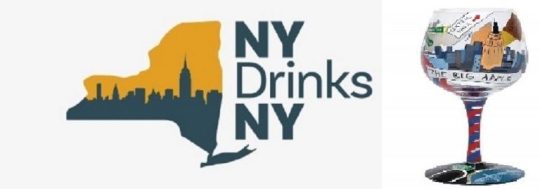
If you live in New York, work in New York or are doing business in New York – there is only one appropriate drink to order…New York State wines.
New York State of Wine
The New York grape, grape juice and wine industries generate more than $4.8 billion in economic benefits annually for New York State. There are 1,631 family vineyards, over 400 wineries, producing 175,000,000 bottles of wine, generating $408 million in state and local taxes (www.newyorkwines.org). New York’s wineries also contribute to New York State’s exports and in 2012, 19.8% of the wine produced in the state was exported.
Wineries and satellite operations attracted more than 5.9 million tourist visits in 2012, spending $401+ million. The tourism industry (including wineries, hotels, restaurants, retailing, transportation) contributes over 6400 jobs to the state, for a total of $213+ million in wages. The tourist is particularly important to the farm wineries, with sales direct to consumers representing approximately 60 percent of total wine sales volume.
The winery industry directly employs approximately 62,450 people and generates an additional 14,359 jobs in supplier and ancillary industries which supply goods and services to the industry and whose sales depend on the wine industry’s economic vitality.
In excess of 101,806 jobs can be linked to the wine industry and these positions average $51,100 in annual wages and benefits. The total wages generated by direct, indirect and induced economic activity driven by the wine industry – $5.2 billon.
New York State Wines and Wineries (Curated)

At a recent Rockefeller Center/ Rainbow Room wine event sponsored by the Wine & Grape Foundation, Sam Filler, the Executive Director of the organization stated, “New York is home to the first bonded winery in the United States, making our state one of the oldest wine regions in the country.” The objective of the NY Drinks NY Grand Tasting, “…is to showcase the diversity, artistry and accessibility of New York’s wine and food landscape.”
The 8th Annual NY Drinks NY Grand Tasting offered access to over 200 wines from approximately 50 wineries across the state.

Keuka Lake Vineyard. 2017. Turkey Run. Vignoles (Finger Lakes)

Located on the slopes above the southern end of Keuka Lake this winery showcases young vinifera and old hybrid plantings that range from 3-years (representing Cabernet Franc and Vignoles), to vines over 50-years of age (representing Leon Millot and Delaware vines).
Thanks to the Finger Lakes, the vineyard produces excellent fruit. The heat of the summer is retained by the lakes and moderates the extreme cold temperatures of the vineyards in winter. As spring approaches, the frigid waters moderate the warming air temperatures and act as a delay for bud break and lower the risk of frost damage.
The terroir is a glacial mix of glacially laid rocks, sand, silt and clay that has been deposited on the lower slopes above Keuka Lake providing for water drainage that is essential for vine balance and health.

Staci Nugent
The owner is Mel Goldman and the winemaker is Staci Nugent. Nugent attended Cornell and did graduate work in California in genetics. Making a career switch, she enrolled in the wine program at the University of California at Davis, receiving a Master’s degree in Viticulture and Enology. Nugent has worked with highly regarded wineries that include Ornellaia, Italy; Hardy’s Tintara Winery, South Australia; and William Selyem, Sonoma, California. Before joining Keuka Lake Vineyards (2008), she was a winemaker at Lamoreux Landing Wine Cellars.

Sustainable farming practices brings the Vignoles to our attention. The grape is made by crossing Seible and Pinot de Corton, is associated with the Finger Lakes and grows well in the gravel soils (glacial till).
Notes: Keuka Lake Vineyards. 2017 Turkey Run Vignoles
Light bright blonde to the eye, the nose is rewarded with lemons, honey, green grapes and sweet oranges, (lemons and oranges) while the palate enjoys citrus and other fruits with the sweetness tempered by a light acidity. Pair with seafood curry, Buffalo chicken wings, pepper and Swiss cheese.
Red Newt Cellars. 2006. Legacy. Niagara Cream Sherry (Hector, New York)

Located on the east side of Seneca Lake (Hector, NY) in the Finger Lakes region, the winery started in 1998 by David and Debra Whiting and the 1998 vintage produced 1200 cases of Chardonnay, Riesling, Vida, Cayuga, Cabernet Franc, Cabernet Sauvignon and Merlot. The first white wines were released in July 1999.
Whiting is considered to be one of the top winemakers in the Finger Lakes Region. Current production of Red Newt Cellars is apprximately 20,000 cases with a white wine focus on aromatic varities: Riesling, Gewurztraminer and Pinot Gris. CIRCLE Rielsing is the most popular and widely distributed wine, made in a classic Finger Lakes style, with hints on tangerine and honeysuckle, citrus and peach on the palate.

Kelby Russell
Kelby Russell is the head winemaker at Red Newt and considered an expert in the art of cold-climate white wines. Thanks to the variable climate of the East Coast, he recognizes that the search for the “perfect wine” is a “false idol, “ finding that the role of the winemaker is to, “…artfully direct what comes into the winery into the best thing and the most honest expression of the year that you possible can.”
At Harvard (Class of 2009) Russell majored in government and minored in economics, was a member of the Glee Club and thought his career would follow a path that would lead to orchestra management. During a study abroad experience in Tuscany he discovered the art and science of making wine.
After graduation, when a job with Jazz at Lincoln Center did not materialize, he visited Fox Run Vineyards and thought he had an interview. The staff was busy with the harvest so he was handed a shovel and offered the opportunity to help on the “crush pad.” This was the begnning of his unpaid internships and he got to spend winters in New Zealand and Australia and autumns in the Finger Lakes as an intern.
His first salaried position in 2012 was with Red Newt as an assistant winemaker. David Whiting, the co-founder and winemaker, promoted Russell to head winemaker and the rest is history. He currently directs the Red Newt house styles and reserves and develops his own Kelby James Russell label with a focus on small-batch wines, from dry rose to Australian-style dry Riesling.

Notes: Red Newt Cellars. 2006 Legacy. Niagara Cream Sherry (Niagara grapes)
The Niagara grape develops into a long-aged solera sherry, creating a complex palate experience.
Bright golden yellow to the eye (think daffodils) with the nose picking up hints of honey, raisins, oranges, apricots, yellow apples, and spices. The finish to absolutely delicious, delivering honey, lemons and spices. Perfect as a dessert course or pair with Blue cheese and pate.
Damiani Wine Cellars (DWC)
DWC was started by Lou Damiani, a Cornell engineer specializing in energy conservation, and Phil Davis. Damiani had an interest in winemaking and his education started in the field of food science before switching to engineering. In the 1990s he returned to study winemaking and mentored under Phil Hazlitt.
In 1996 Damiani wanted to plant Cabernet Franc and Merlot and visited an old friend and college friend, Phil Davis, who was also a viticulturist. They started the project and in 1997 Hazlitt pulled out a hybrid vineyard and planted Cabernet Sauvignon, Pinot Noir and Merlot. When their vineyards started producing in 2003 the next step was to make world class red wines.
Damiani was the head winemaker from 2003 – 2011 and he trained Phil Arras to continue and improve the DWC tradition. In 2007 Glenn Allen joined as a Business Consultant and later became a partner in the enterprise. Today DWC has four main vineyard sites with approximately 40 acres of land under vine and a new tasting room that hosts events and is the retail outlet.

Phil Arras, originally from Philadelphia, moved to the Finger Lakes in 2003 to attend Cornell University and majored in philosophy and political science. Inspired by a class on wine appreciation, Arrras changed his career focus to winemaking. He was hired by Damiani Wine Cellars in 2009 as the assistant winemaker and began “on the job” training. In 2012, Arras became head winemaker.
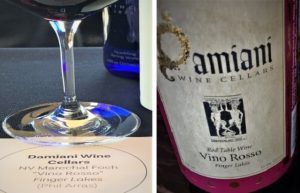
Notes: Damiani Wine Cellars. NV Marechal Foch “Vino Rosso” Finger Lakes. (Varietal may be a cross between Goldriesling and a Vitis riparia/Vitis rupestris or a cross between Gamay Noir and Vitis riparia – Oberlin 595).
Deep ruby color to the eye, an undertone of tomatoes runs alongside notes of plums and apricots and the tannins are so soft as to be obscure. Pairings might include pasta, barbeque and smoked gouda cheese.
Thirsty Owl Wine Company. 2017. Traminette
Ted Cupp purchased 150 acres of frontage on Cayuga Lake from Robert and Mary Plan, trailblazers who started the Cayuga Wine Trail in 2001. During 2001 and 2002 he began construction on the winemaking facility and tasting room for the Thirsty Owl. In 2002, in cooperation with Shawn Kime, he planted Cabernet Sauvignon, Syrah, Pinot Noir and Malbec. When the doors to the winery opened in 2002, Thirsty Owl had produced 1200 cases.

Jon Cupp, President
Today, the Thirsty Owl is synonymous with award winning wines, including the Governor’s Cup and the John Rose award for Rieslings. The Pinot Noir had the highest rated North American Pinot at the Taster’s Guild International Competition. Thirsty Owl produces Malbec and Syrah as well as blends, reds, whites and ice wine.

Shawn Kime
The winemaker and vineyard master, Shawn Kime, is originally from Romulus, New York and attended Morrisville College and Cornell University. Kime started to work in agriculture at the age of 14 and started winemaking after spending 2 years working with one of the earliest Finger Lake Vinifera growers.
The goal of the Thirsty Owl is to “…make changes in the vineyard and winemaking based on the year to produce wines that not only reflect our region but the growing season…. As a Finger Lakes native, I am proud of the fact that we are producing cool climate varietals that are on par with any region in the world.”

Notes: Thirsty Owl Wine Company. 2017 Traminette (cross between Gewurztraminer and Joannes Seyve 23.416).
To the eye, highlights of golden yellow. The nose finds apricots, peaches, pears, honey and fresh lemons as well as florals (especially roses and tulips) and a bit of spice. The palate is entertained with citrus and lemons, oranges and a bit of earth. The finish brings light acidity making it an interesting dessert wine.
Pair with spicy/sweet and sour sauces on chicken, pork and veal and Cheddar, Fontina and Gruyere cheese.
Benmarl Winery. 2015 Baco Noir. Hudson River Valley
Benmarl (slate hill) Winery is located in Marlboro, NY and covers 37-acres and is considered to be the oldest vineyard in America (it holds New York Farm Winery license no.1). It was owned by magazine illustrator turned vintner Mark Miller from 1957 -2003. In 2006 Victor Spaccarelli purchased the vineyard and Matthew Spaccarelli is currently the winemaker

In the 17th century, wine was being made by the French Huguenots in New Paltz, New York. Andrew Jackson Caywood started his vineyard in the early 1800s. The community was incorporated as the Village of Marlborough, a cluster of grapes carved in its seal commemorated its major crop (1788).
Caywood became an important viticulturist and leading authority in the development of new grape varieties. The Miller family bought the Caywood property in 1957 and renamed it Benmarl. It was purchased in 2006 by the Spaccarelli family. They replanted many abandoned vineyards, refurbished the estate and carry on the tradition of experimentation, planting new hybrid varieties like Traminette as well as Old World vinifera.

Notes: Benmarl Winery. 2015 Baco Noir. Hudson River Valley
The Baco Noir, made from estate-grown fruit, brings dark plum hues to the eye, and delivers the aromas of dark plums, cedar and sage to the nose. On the palate are flavors of blackberry with hints of spice. Tannins give it a structure that is delicious and the finish delivers spice and black berry fruits. Benmarl has been producing Baco Noir for 50 years. Pair with pork roast, pasta with meat sauce, beef burgers with blue cheese.
The NY Drinks NY Event
The elegant Rainbow Room @ Rockefeller Center was the venue for the New York Drinks New York event. As an important wine trade events, many hundreds of wine buyers, sellers, sommeliers, wine educators, and writers convened to experience a wine-range of quality wines produced in New York State.
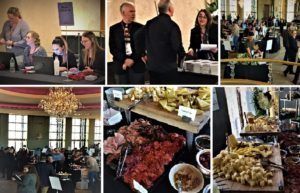
Wines of Distinction included:
Brotherhood Winery
Brotherhood Winery is the oldest continuously operating winery in America, producing wine for 180 years in Hudson Valley. It features one of the most modern bottling facilties for wine on the East coast, with a capacity of 1.5 million cases er year. A wine current featured focuses on low calories (approximately 90 calories per glass).

Glenora Wine Cellars
Glenora Wine Cellars produces award-winning Finger Lakes wines for over 40 years with a focus on sparkling wine and Riesling, sourcing grapes from 13 growers across four of the Finger Lakes. Glenora opened the first winery on Seneca Lake (1977).

Saltbird Cellars
Robin McCarthy is the owner and winemaker at Saltbird Cellars that started in 2014 and, based on the unique maritime terroir, developed Stainless Steel Sauvignon Blanc, Migratus Barrel Fermented Sauvignon Blanc and Stainless-Steel Chardonnay.

Hosmer Winery
Hosmer Winery is located on Cayuga Lake in the Finger Lakes. Grapevine plantings date back to the 1970s and early experiments with plantings of classic Vinifera started in 1985. The 70-acre estate includes Rieslings, Chardonnays, Cabernet Francs as well as French-American hybrid varieties.

For additional information: @NYWineGrapeFdn and NYWineGrapeFdn
© Dr. Elinor Garely. This copyright article, including photos, may not be reproduced without written permission from the author.
Travel News | eTurboNews
Original Article
The post Drink like a New Yorker appeared first on Tripstations.
from Tripstations http://bit.ly/2GorBpZ via IFTTT
0 notes
Text
Paper代写:Life education in British universities
本篇paper代写- Life education in British universities讨论了英国高校的生命教育。在一些慈善机构的影响下,英国政府开始重视生命教育的推进工作,并且将生命教育作为一种全人教育来推进。生命教育是一种具有促进个人与社会协调发展功能的教育,能够让学生从不同角度去理解民主的本质,以及参与民主的意义。此外,生命教育有助于促进个人的健康和幸福,尤其是让学生意识到毒品的危害,从而树立起正确的生活习惯与生命价值观。英国高校的生命教育发展到现在,已经成为英国教育体系的核心之一,逐渐成为英国教育的基础内容之一,并且建立了系统性、法制化的教育体系。本篇paper代写由51due代写平台整理,供大家参考阅读。
In recent years, there have been many regrettable and shocking student suicides on college campuses in China, which not only reveals the indifference of suicidal students to life, but also reflects the imperfection of life education in colleges and universities. From the perspective of reality, the defects of college life education in China are mainly reflected in two aspects: on the one hand, the lack of psychological crisis intervention; on the other hand, the lack of life education. As the first country to develop life education in the west, Britain is also the country with the most perfect life education system at present.
Life education in the UK was first advocated by Ted Noffs. He is a social worker who has long been concerned about youth drug use. He believes that it is necessary to carry out life education in society so as to reduce the harm caused by drug abuse. In 1986 Britain's first life education institute was established, funded by Varity Culb. In 1987, the life education center established the life education foundation, whose main role is to raise funds to improve the lives of drug addicts. In March 1987, under the sponsorship of Rock Group Dire Straits, a second mobile life education institution was established. Since then, more than 30 mobile classrooms have been set up across England, wales and Belfast. These institutions have played an active role in reducing the harm of drugs and so on.
Under the influence of these institutions, the British government began to pay attention to the promotion of life education, and life education as a whole-person education to promote. British educationists generally believe that life education is not only about individual life, that is, the focus on one's own life, but also about making individuals pay attention to society and cultivating their ability to pay attention to society. Life education is an education with the function of promoting the coordinated development of individuals and society, which can enable students to understand the essence of democracy and the significance of participating in democracy from different perspectives. To enable students to understand the responsibilities, obligations and rights of citizenship, the relevance and significance of others, schools and society to themselves. In addition, life education helps to promote personal health and happiness, especially to make students aware of the harm of drugs, so as to establish correct life habits and life values. Life education has become one of the cores of the British education system, and gradually becomes one of the basic contents of the British education, and a systematic and legal education system has been established.
Under the active promotion of the British government, life education in the UK has formed a systematic education system, which, together with civic education, constitutes the education mode with the main and the auxiliary. As an important part of civic education, life education is not only a compulsory course in universities, but also brought into the orbit of legal management. In addition, life education courses in the UK attach great importance to teaching activities such as role playing and group discussion. Combined with multimedia, network and other technical means to create a learning environment in line with the real life, so that students deepen the understanding of life education, harvest more valuable knowledge about life.
Focus on life education. Life education in Britain emphasizes learning in many aspects, especially experiencing the essence of life from life. Therefore, life education is not only an abstract knowledge education, but also the perceptual knowledge of life. The content of the course are generally based on real events, often refer to some recent cases involved into the class discussion, thus let the students to realize what is a democratic participation, what it means to be citizens responsibilities, rights and obligations, etc., let the students know the process of personal growth for citizens from life, personal and school, the relationship between the individual and society, and the value of individual existence with others.
The purpose of life education is not only to promote the socialization of individuals, but also to make people feel happy and develop healthily in the process of development. Life education believes that it is necessary for students to know themselves, recognize the importance of self, and establish self-esteem, self-confidence, have an independent spirit and sense of responsibility, so as to become active members of a democratic society, actively contribute their talents and wisdom to the development of a democratic society, and share their achievements with others.
As a result, the life education in content contains the student life as a whole and its process of all life, all the discussed depart from life, to enable students to have with the knowledge necessary to become a qualified citizen, and have the ability to development and explore all kinds of problems, good communication skills and ability development.
Life education in Britain is a kind of integrated education. Life education is not an isolated education, but closely linked with other courses, so that life education becomes a part of daily education. That is to say, life education is carried out all the time, so this kind of influence is very huge. In addition, the integration of life education with other courses is conducive to students' understanding of the essence of life from different professional perspectives, which is conducive to the formation of a comprehensive understanding of life and the ability to see differences in the whole.
In recent years, some extreme campus events have occurred frequently and it is urgent to carry out life education. Although relevant contents of life education have been incorporated into the education system in the outline of national education development plan, colleges and universities are still at the exploratory stage in life education, which calls for unified curriculum guidance and capital investment and guarantee. The successful experience of British life education can bring us many beneficial inspirations.
To strengthen the leading role of the government and develop life education, the government's support and guidance are indispensable. First, the government should bring life education into the legal management track, and bring life education into the national curriculum system standard. The national curriculum system standards for life education should be set up, the specific teaching objectives should be formulated, the teaching tasks should be designed, the scientific teaching methods should be determined, and the reasonable teaching evaluation methods should be adopted. To guide colleges and universities to carry out life education in accordance with regulations, strengthen supervision and assessment, and incorporate the implementation effect of life education into the comprehensive evaluation index system of colleges and universities. Secondly, the government should increase the funds for life education. In terms of funds, it guarantees the curriculum research and development of life education, the accumulation of curriculum resources, the training of teachers and the construction of practice bases. Finally, on this basis, the government should encourage all kinds of social organizations to play their function of connection and bond, provide diversified support and services, and create conditions and build platforms for life education in colleges and universities.
From the experience of the UK, the development of life education needs a long process. First of all, we should proceed from the actual situation of our own country and not copy it. Colleges and universities should establish the consciousness of long-term development of life education, bring life education into the scope of college curriculum construction, actively optimize the curriculum setting, and integrate life education into the whole process of students' study in school. At the same time, life education into different disciplines, so as to achieve a subtle effect of education. Secondly, innovate the teaching mode and enhance the appeal of life education. Life education should be people-oriented, combining life education with students' inner needs, so as to make life education a kind of education close to students, life and reality. Furthermore, a professional psychological counseling platform for life education should be established to integrate life education and mental health education. Finally, schools should try their best to provide necessary teaching facilities, teaching tools and teaching places for the development of life education, so as to provide a solid guarantee for the development of life education.
A survey on life education shows that 89.3% of college students have had extreme psychological experience, such as extreme disappointment, extreme anger, extreme loneliness, etc., but only 8% of them have sought help. It can be seen that strengthening life education is a systematic project, which needs to give play to the synergistic effect of various departments of colleges and universities. In particular, moral education teachers, psychological counseling teachers and counselors should become the navigator of life education for college students. Moral education teachers should make good use of ideological and political theory class, for example, the main position, adhere to the guidance of marxist ideology, with the socialist core values education as the breakthrough point, guides the student to set up the broad ideal, the right attitude towards life difficulties and setbacks, to improve the ability to adapt, to enhance the social sense of responsibility, set up the correct viewpoint and help students perfect personality, treat life, healthy growth, become self-reliant, independent, self-improvement, since the new new college students.
From the perspective of British teaching experience, life education should emphasize practicality. Due to the long-term influence of examination-oriented education, teaching activities in China often remain at the theoretical level, with relatively little exploration at the practical level. Therefore, in the process of developing life education, we must pay attention to the practical characteristics of life education, otherwise it will seriously affect the implementation effect of life education. College students are in the flourishing period of physiology, have strong plasticity in spirit, and have strong practical ability and innovation ability. Therefore, the university curriculum should focus on practice, so that students have the opportunity to grow their talents in practice, so as to better adapt to the society.
Colleges and universities should actively organize various social activities to provide a platform for students to participate in the practice, so that they can experience life, feel life and understand life in practice.
要想成绩好,英国论文得写好,51due代写平台为你提供英国留学资讯,专业辅导,还为你提供专业英国essay代写,paper代写,report代写,需要找论文代写的话快来联系我们51due工作客服QQ:800020041或者Wechat:Abby0900吧。
0 notes
Text
10 Reasons Lifting Is Better Than Cardio - Weight Loss - VEGA SAĞLIK | Scitec Türkiye Distribitörü
Son dakika haberleri Alanya'nın en hızlı internet haber sitesi Alanya Express'te http://www.alanyaexpress.com/10-reasons-lifting-is-better-than-cardio-weight-loss-vega-saglik-scitec-turkiye-distribitoru/
10 Reasons Lifting Is Better Than Cardio - Weight Loss - VEGA SAĞLIK | Scitec Türkiye Distribitörü
Not all exercises are created equal and you should know that by know. Regardless of your personal preferences, there are objectively lousy exercises and highly effective exercises; while the majority of moves belongs somewhere in the middle. But can the same be said for training regimes? Today we’re going to take up the rather challenging task of comparing resistance training against running and cycling and finally deciding who rules them all. Why is that necessary, when both weightlifting and cardio training seem to offer unique health, fat loss and muscle-building benefits? Because first, it will help us debunk some ugly myths about both lifting and cardio routines and set the record straight, and second, we’ll get to describe in detail why resistance training is the second greatest idea in the world after the invention of the wheel. Yeah, we’re pretty confident about the winner because we’ve done our research – to resolve the strength training vs. cardio conundrum, we’ve dig out tons of scientific evidence and consulted many experts on the subject. In fact, some athletes and training gurus have been recently arguing that the fitness world is ready to ditch cardio altogether. Ouch! We hope that won’t really happen, though. You can’t get everything from one type of training and running and cycling have an integral place in a well-rounded fitness program. That’s a solid fact and this article is based on utmost respect for these forms of exercise. However, whenever any truth-lover attempts isolate the benefits from both strength training and running/cycling and stack them up against each other, strength training emerges as the superior choice. And if you don’t have time to have that well-rounded fitness program we mentioned, it’s much better to grab a barbell than hit the pavement. Here are 10 bullet-proof reasons why. #1. Running Only Builds Muscle in the Lower Legs follow me for more tips @ty_zan Ty Zan (@ty_zan)’in paylaştığı bir gönderi (Oca 12, 2016 at 8:42öö PST) We all know that runners have amazing calves and quads, but that’s usually the end of the story with the exception of runners with freakish genetics. There’s really no surprise here – running primarily stresses the ankle joints and the cardiovascular system and it doesn’t require a big enough range of motion to stimulate significant muscle growth elsewhere. On a side note, have you noticed that sprinters often rely on strength training to increase their speed and power? That’s because running by itself doesn’t allow them to apply the greatest training stimulus required for maximizing their results – after the beginner phase, the main benefits come in the form of cardiovascular conditioning. But do you know which form of training will help you build (and keep on building!) whole-body muscle strength and mass? That’s right. #2. Cycling Promotes Bad Posture 3×12 Ty Zan (@ty_zan)’in paylaştığı bir gönderi (Oca 13, 2016 at 4:42öö PST) Here’s the problem: cycling does nothing to develop the hips or the upper body, which is why many cyclists who have the bragging rights for monster quads suffer from an embarrassing absence of gluteal development. Also, the cycling position is not natural, since our spine is designed to have three balanced curves that make up its S-shape. When you’re on a bike, your spine rounds forward from the tailbone to the shoulders and your spine loses its natural shape. Over time, this can easily lead to a network of health issues and dysfunctionalities, such as lower back disorders, terrible posture and a “pancake butt” comprised of mostly inactive glutes. #3. It’s All About Strength – and Strength Training Does It Better Regardless of which physical attribute you worship the most – agility, speed, size, strength, balance, etc. – you have to admit that strength is the quality to rule them all. Stronger muscles can do everything better! Orchestrating more powerful jumps? Check. Protecting your joints and connective tissues? Yep. Lifting ridiculous amounts of weight? Absolutely. And as you may already know, nothing builds muscle strength like the progressive overload implemented in strength training. #4. Strength Training Boosts Metabolism More Powerfully When you increase your muscle mass, you boost your resting metabolism, which makes your body burn more calories. Lean muscle mass requires more fuel for everyday functioning than fat, so the more muscle mass you have, the more calories you can burn just by living and breathing. Then, weightlifting creates a lot of muscle damage that increases post-workout metabolism because it takes energy to repair the muscle fibers you’ve destroyed while training, which equals to even more calories burned. Of course, intensive periods of running or cycling also create muscle damage (mostly to the legs!) and spark up your metabolism, but this is dramatically less than what you’d get from a regular resistance training routine. One recent study from North Dakota State University found that you can burn 346 calories in just 13 minutes of performing a 6-exercise resistance circuit, while running at a 10-minute mile pace for the same amount of time will only burn 146 calories. Another study showed that 12 minutes of kettlebell swings had the same metabolic impact as running for 12 minutes, but with the added benefits of strengthening many muscles that are neglected when running. To burn more calories, you need to up both your anaerobic and aerobic energy expenditures, which is best done with high-intensity total-body resistance training (according to science, it’s even better than HIIT cardio). So if you want to rev up your metabolism and lean out as fast as possible, resistance training should be the cornerstone of your program, period. 5. Strength Training Does Wonders for Mobility Remember how all strength training articles stress the importance of completing a full range of motion? This is how resistance exercises are correctly performed. A greater range of motion brings many benefits, one of which is improving joint mobility. Neither running nor cycling offer this potential – in fact, it’s generally terrible for people with mobility issues. You can see the difference by comparing a simple exercise like the lunge with running – lunges will strengthen your hips and thighs, improve hip mobility and fix existing muscle imbalances, while running will only strengthen your leg muscles, especially the calves. Try to compare any classic strength-building exercise with running and you’ll get the same result. #6. Strength Training Will Reduce Your Risk of Injury And yet the opposite is not true. As it turns out, running can be a rather dangerous sport – recent research has shown that as many as 79% of runners get injured at least once during the year. Physiotherapists have claimed for ages now that excessive running and cycling can create a multitude of inherent imbalances within the organism, mainly because of the limited range of motion and endless, repetitive movement patterns, which is basically a recipe for overuse injuries. So how can runners, or anyone else for that matter, protect the health of their joints and connective tissues? By incorporating an adequate amount of strength work into their fitness regime, of course. Besides its ability to strengthen your muscles and tendons, strength training also enables you to fix strength imbalances, improve muscle coordination and prioritize natural, functional movements of the body that can’t be trained with running and cycling. By the way, research on the subject has shown that lack of hip strength and poor development of the core muscles are one of the most frequent causes of common running injuries, and recommended that runners perform strength training to identify and improve their weak areas. #7. Strength Training Builds a Better-looking Physique Ty Zan (@ty_zan)’in paylaştığı bir gönderi (Kas 23, 2017 at 6:50öö PST) Kind of a no-brainer here. Unless your idea of physical aesthetics is radically different from the one endorsed by most people, you have to agree that, if done properly, strength training can help you build a spectacular physique by maximally developing every muscle in your body, while cycling and running will mostly affect your calves and quads (and possibly weaken your posture). A high degree of aesthetics is all about the optimal balance between size, proportion, symmetry, and body fat percentage. There are many people with greatly-built bodies out there that haven’t gone through a lot of running, but almost all of them have done strength training for longer periods of time. #8. Strength Training Offers Immense Exercise Variety “Novelty or training variety are important for stimulating further strength development”, claims a study published in the Journal of Strength and Conditioning Research, and we couldn’t agree more. Varity is the key for breaking or even avoiding the vicious cycle of monotony and loss of motivation, and in combination with progressive overload, it’s what helps lifters keep on making strength and mass gains. As you have probably experienced by yourself, cycling and running don’t offer a whole lot in this department – the choice between uphill or downhill running/cycling isn’t exactly what we’d call a wide range of options. On the other hand, there are dozens of ways to do squats and all of them pack unique benefits! The same can be said for a great number of major upper body and lower body exercises. You can always easily up the challenge and keep your workout interesting by modifying familiar movements and adding little twists to exercises you’ve properly mastered, or you can choose a completely different set of exercises which train the same muscles in a different way. And that’s how you build a complete, healthy and well-defined physique. #9. Strength Training Helps Slow Down Aging One recent study showed that strength training in people aged 40 and above can reverse oxidative stress and return no less than 179 genes to their youthful status, and the same cannot be said for cycling/running. Furthermore, this exercise form has been found to directly impact 10 biomarkers of aging in a positive way. According to S. Melov and M. A. Tarnopolsky, the authors of a 2007 study named “Resistance Exercise Reverses Aging in Human Skeletal Muscle”: “Quite literally, the resistance training was not only slowing, but also reversing the aging process at the gene level. The gene expressions of the resistance trained older subjects demonstrated characteristics similar to those of the younger group. The researchers also noted that mitochondrial impairment, normally seen with inactivity, was reversing with the 6 months of resistance training.” And what about muscle mass los and reduced bone density, which are one of the most common negative attributes of aging? Countless of studies have shown that resistance training is the best way to preserve muscle mass and bone density and prevent osteoporosis, which is why this type of training is most commonly recommended to older people. By preserving muscle mass, they can maintain a high metabolic rate and avoid a series of health issues such as metabolic disorder, diabetes, hypertension, etc., associated with fat gain which is known side-effect of both aging-associated muscle loss and muscle loss in younger people. #10. Strength Training Will Extend Your Lifespan By now, it’s clear that strength training does a lot more than increasing muscle size and strength. Some researchers have actually claimed that it is the most healthful form of exercise there is, because it protects bran health, prevents sarcopenia, lowers the risk of heart disease, diabetes and cancer and actually substantially lowers the death rate of cancer survivors, just to mention a few. It can also improve hormonal balance and prevent mood disorders, depression and anxiety, as well as enhance cognitive skills in both older and younger people. And by adding up the health-boosting, disease-preventing and anti-aging benefits of strength training, it’s easy to conclude that this type of exercise can increase your longevity. But there’s more. Some new studies have found that weightlifting can directly increase your lifespan. How? By lowering the level of myostatin in your body. Miostatin (also known as growth differentiation factor 8 or GDF-8), is a myokine produced and released by myocytes that inhibits myogenesis, i.e. growth and differentiation in muscle cells. The way in which weightlifting increases the size and strength of your muscles is lowering the level of myostatin. According to these studies, less myostatin also means about 15% longer life. On top of that, if there’s one thing that could keep your self-confidence stable and body image positive during your golden years, it’s having a high-degree of strength and mobility, both of which can be maximized and maintained with the help of strength training and weightlifting. Among other things, this will lower your risk of bone fractures, back pain, osteoarthritis and atherosclerosis. On the other hand, running is a pretty high-impact exercise that isn’t recommendable for most seniors, although some studies have yielded interesting contra-arguments to this. Still, besides improving cardiovascular health, strengthening segments of the lower body and eliminating stress, running can’t do all that much for anyone. Cycling could be done forever, but… for what purpose? Just like running, it won’t do anything to develop your upper body and core muscles or improve your posture, stability or balance. It can’t even help you reverse the effects of excess sedentary activity and it’s unable to stimulate effective and dramatic fat loss as strength training can. Running and cycling simply cannot be compared with strength training in any terms, including short-term and long-term health benefits. Do you want to be able to move with ease and vitality, keep your mind sharp and quick, and feel energized and balanced until your very last day? Then make strength training the cornerstone of your fitness program. Period. And if you have the time and desire to do it, add some running and cycling sessions to boost your gains even further. Good luck! Bonus Video :
kaynak: 10 Reasons Lifting Is Better Than Cardio – Weight Loss Fitness, erkek kılavuzu, kadın, egzersiz, kilo kaybı, sağlık, beslenme, kas ve vücut geliştirme, sağlıklı erkeklerin yaşam bloğu Vegasaglik.com.tr
kaynak: 10 Reasons Lifting Is Better Than Cardio – Weight Loss – VEGA SAĞLIK | Scitec Türkiye Distribitörü
Fitness, erkek kılavuzu, kadın, egzersiz, kilo kaybı, sağlık, beslenme, kas ve vücut geliştirme, sağlıklı erkeklerin yaşam bloğu Vegasaglik.com.tr
Kaynak: http://www.alanyaexpress.com/10-reasons-lifting-is-better-than-cardio-weight-loss-vega-saglik-scitec-turkiye-distribitoru/
#Beslenme#egzersiz#erkek kılavuzu#Fitness#Kadın#kas ve vücut geliştirme#kilo kaybı#sağlık#sağlıklı erkeklerin yaşam bloğu#SAĞLIK
0 notes
Text
Lago Maggiore . Isola Bella
Our last day and it was the hottest. We had to pack and clean the apartment and also do our washing as I wasn’t sure where the next place with a washing machine would be. We left the apartment quite late and head out with the ambition of getting lunch at another beach club I had read about called Meina Beach Club but we had missed lunch service so carried on driving around the easterly side of Lake Maggiore until we reached Stresa. Stresa is the most well known town on Lake Maggiore. I had read up on this place before we arrived and was excited to see the architecture of some of the famous grand hotels. The town had previously been owned by the Borromeo family and the town was a popular retreat for European aristocrats. This is reflected in the architecture as a varity of different types can be viewed whilst looking at the grand hotels and manor houses that take up the lakefront. From Art Nouveau to the more modern takes on Baroque architecture they are definitely as flamboyant and ornate as you can imagine. Princess Margaret used to apparently holiday at Stresa back in the day as well.

From Stresa we hopped on to one of the many water taxis to visit Isola Bella. One of the several small islands that are dotted on all of the lakes. Isola Bella was the one that I had read about and looked to be the most beautiful so we decided to only visit this one.

We arrived late so the main manor house was closed to the public and so we couldn’t actually walk around the English garden styled grounds of the house but we could see a great deal from the boat as it was. There are apparently white peacocks that wander around the estate and I have to be honest I am kinda glad we didn’t get to see them as I hate peacocks.

We walked around a few of the small streets around the main manor house and walked around the strategically placed tourists stalls trying to sell you the same fake pashmina or Isola bella t shirt or fridge magnet time and time again. The variety of food was also limited to boring tourist ice creams and slushpuppies until we stumbled on this deli restaurant that was serving ham and cheese platters and artisan beer.

Of course we stopped and it turned out to be a real hidden gem. It completed our time on the lake in a fantastic way and was a welcomed little break from the baking sun that seemed a lot hotter on the island. We were two of the last tourists left on the island before we jumped on our water taxi back to the mainland. Watching the islands disappear into the distance concluded our time in Northern Italy.
#lakemaggiore#isolabella#italy#travelling#europe#roadtrip#stresa#beer#couple#islandlife#islandhopping
0 notes
Text
Varities Of Banquet Recipes By FoodStalking
Most of modern love stories starts with a date and more prudently with a dinner date. In fact, the first question that pops out of a lover’s heart to a wanting person is DATE and dining is an integral part of dating but why? There are numerous theories attached to this craving: some say it augments bonding and understanding while speaking about your personality, while others say it keep burning your love life with unforgettable memories, amongst a host of others.
Let’s put theories before the analysis cart and drive to answer of why you should dine on date
1.A complete Personality judgement program : Well, we all have seen typical Bollywood movies, in which our heroine judges the winnable (of course by his father) on date specially the behavior he exhibits toward poor waiter or door keepers or managers and she declares him a villain.

Yes! You can judge your partner with such exhibition of his personality. Be it his choice of cuisines, be it his behavior with others, be it his way of eating and be it his caring attitude toward you. These all reflects his personality parts such as his/hers short-temperedness, anxiousness, arrogance, high-headedness, ego, which can prove to be detrimental in a long-term relationship.
So, next time you date, take note of all these things he or she reflects own personality in hours of dining.
2.Habits Don’t Matter: A blunt truth about all of us is ‘we all have some bad habits ‘. These bad habits are one of the repulsion factor between couples. On dinner date when you and your partner date, you have only glimpses of his or her temporary personality but regular Dining together gives a strong reflection of the habits you relish. So, while your partner try to be shy in eating in your first few dates, regular dates will pull away your timidity and opens you up.
So, your continuous dates will definitely be instrumental in bringing you out openly. You in the end will not just relish the cuisine but, also the company of your ‘would be’ and his habits.
3.Strengthens Understanding: a bare truth about the harmony in real life is that we all have to compromise on small issues with our partner in life. When relation goes sour, these small issues is not only starter but gradually becomes main course. So your date start teaching you such lesson at a very start.
At times it becomes hard to decide as to what to order for eating at a new restaurant or even at an old, tried and tested place with your ‘date’, as it is not always the case that both the individuals are foodies and love dining outside. Arguments may unfold at such instances. But, how to handle those small spats in a successful manner that it is not just romantic but, becomes a life-long memory bringing the two people closer is another major benefit of dine dates.
So your continuous dining dates will teach you to put small things behind and how to romanticize even small spats.
4.A Bonding express: A ‘dine date’ helps in bringing together two individuals who may be planning to settle with each other for the rest of their lives. Dining creates a healthy bond between such individuals, a feeling of oneness, togetherness that tells you that ‘Yeah there is someone exclusively for you who looks ahead of being with you’.
So, dining together creates closeness and an urge within both the parties to meet each other more often and you can take it forward to another level. Such a great time Sweet or dessert make the relationship perfect. So for best Indian Dessert Recipes contact Foodstalking.

5.Feeling Blessed: A dine date also chalks out the interest of your date in you. At a restaurant, you may come across several couples who may be arguing over different matters and such a scene might make you realize how blessed you are with your partner.
So here by you must have concluded not only why you should dine on date but also how to impress your partner on date.
0 notes